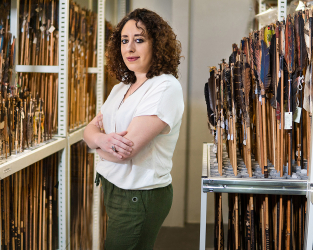Introducing Visiting Conservation Researcher Ana Carolina Delgado Vieira

Working on a sandwich doctorate in conservation at UCLA has nothing to do with choosing rye over wheat for Ana Carolina Delgado Vieira. Rather, the Brazilian conservator from the Museum of Archaeology and Ethnology (MAE) at the University of São Paulo, where she has been head of conservation since 2013, is a participant in a Brazilian program that provides scholarships for doctoral candidates to go abroad for educational opportunities not available in Brazil.
Those in the Capes-Print program-CAPES Foundation in which she is participating have the chance to gain international experience and establish new contacts, as well as access technologies unavailable to them in Brazil, according to Delgado Vieira.
The opportunity for her was created through the doctoral program at the UCLA/Getty Interdepartmental Program in the Conservation of Cultural Heritage in the Cotsen Institute of Archaeology. With the full support of her institutional sponsors, she is at UCLA until March, 2024 as part of the UCLA program “that trains students in the highest standards of conservation practice,” she explained. “This program is very focused on archaeological and ethnographic materials…and in Brazil, our focus is more on sculpture, paintings and documents,” she added.
“So to work with archaeological materials, we have to go abroad. I did my specialization a few years ago in Peru, but I always admired the UCLA/Getty program. I followed the news and attended virtual events,” before this opportunity arose, she said.
Delgado Vieira began her PhD program at the Institute for Energy and Nuclear Research (IPEN) in 2021 under the supervision of Prof. Dr. Pablo Vasquez. Her project aims to evaluate how ionizing radiation affects pesticide degradation. In her role at IPEN, she works on the Cobalt-60 Multipurpose Irradiator, a technology that is entirely Brazilian, was pioneered in the country, and is utilized by cultural institutions to preserve their collections, she explained.
At UCLA, she is primarily working with Thiago Puglieri, assistant professor of the department of art history and the UCLA/Getty conservation program. “Ana Carolina is here to investigate the use of Surface Enhanced Raman Scattering (SERS) in the detection of pesticides in ethnographic items and in the confirmation of pesticides’ degradation by gamma radiation,” according to Puglieri.
“I’m getting full support from my museum for the research I’m doing because they feel the research is important for the University of Sao Paulo (MAE-USP),” Delgado Vieira said.
She explained that the museum has more than 150,000 objects in their collection, including stone, ceramic materials, wood, “a lot of feathers,” and basketry. “The collection is really amazing,” she added. However, much of the collection had pesticides applied up to four decades ago, according to Delgado Vieira. She noted that many anthropological museums used the same pesticide recipes with collectors trying to apply conservation materials to the objects they collected. “Museum employees, as well, have employed a variety of toxic chemicals through direct application to objects,” she noted.
“We have a problem not only for people working in the museums with these objects, but often with source communities in Brazil,” she explained. She noted that people in these communities “want to see and review the objects, and they often work closely in our storage areas. So the contamination issue is really a big concern. Because of this, I am trying to develop some protocols to decontaminate objects, and we want to investigate if SERS can be used as a tool to evaluate if the decontamination is working.
“We use personal protective equipment” when handling the objects, but “when we are talking to and working with Indigenous communities, sometimes they want to have direct contact with the objects. So it is important to try to make efforts to decontaminate,” for their protection, she added.
Delgado Vieira pointed out that these pesticides are very toxic. So those in close contact can develop cancer, headaches, stomach problems, and other dangerous neurological side effects. There are few records available as to what objects have been treated because it was “kind of routine,” she explained, “so we assume that the majority of the collection is contaminated.” She has brought samples with her from Brazil on which to test the SERS technique to detect pesticides. There are existing techniques to analyze objects for pesticides, but they are all very expensive and time-consuming, she said. There is almost no literature on the use of SERS to detect pesticides in cultural heritage, according to Delgado Vieira. At UCLA, she will test the gamma radiation applied in São Paulo, as well as the effectiveness of SERS.
Delgado Vieira has not had the chance to start working on objects yet because the requisite laboratory at the Getty Center will not be available until January. However, she has been following the courses of Puglieri and Professor Ellen Pearlstein. For now, she says, “it is just PDF files and writing articles.” But in December, her husband will visit, and in February, her mother will come from Brazil. Those visits will “be a good opportunity to discover more of Los Angeles and to have fun,” she added.
Published on December 4, 2023.


